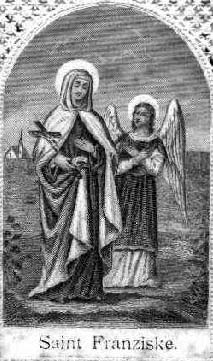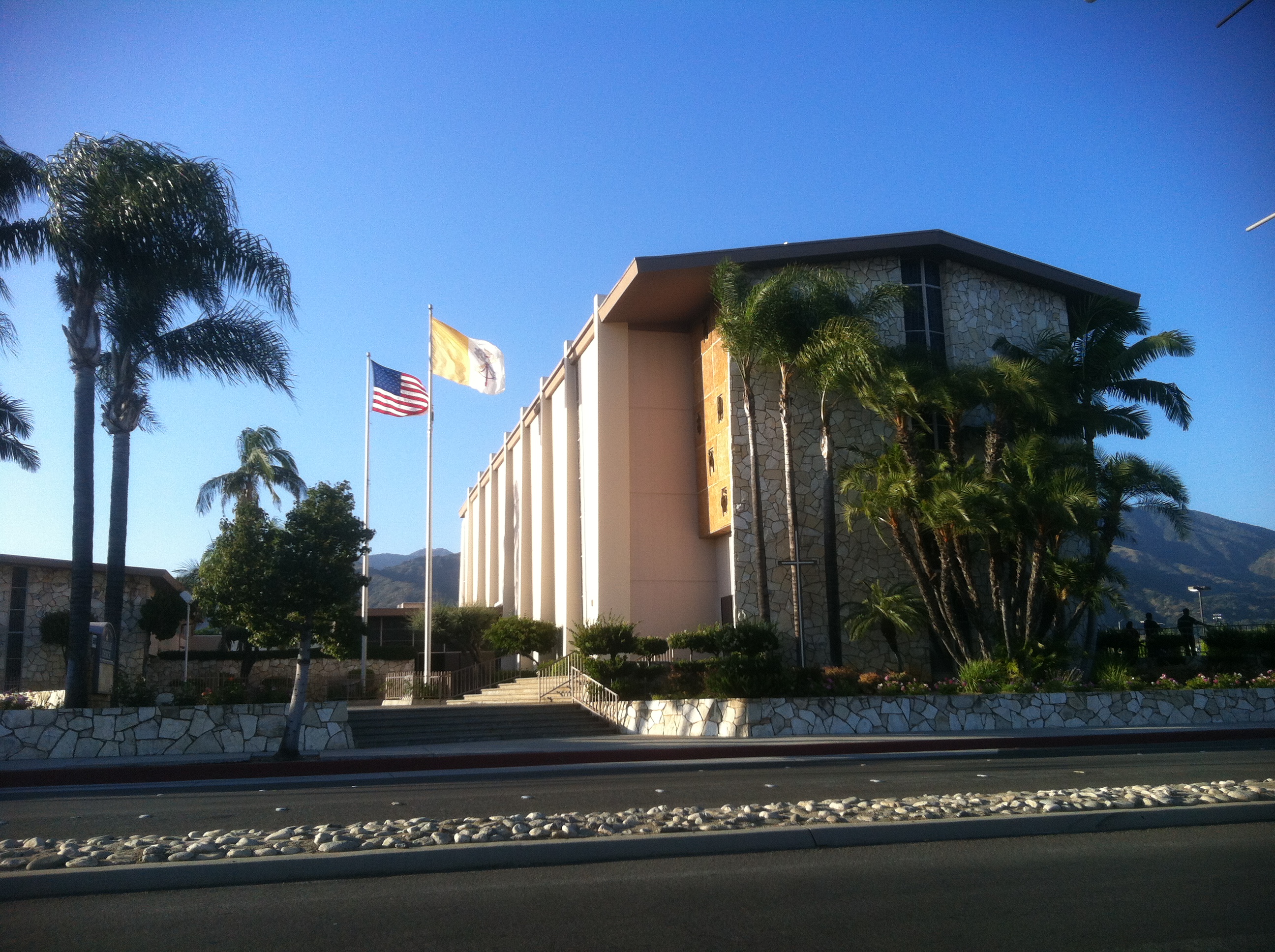|
Our Patron Saint:

St. Frances of Rome
Saint Frances of Rome, Obl.S.B., (Italian:
Santa Francesca Romana) (1384 – March 9, 1440) is an Italian saint who was a wife, mother, mystic, organizer of charitable
services and a Benedictine oblate who founded a religious community of vowed oblates.
Biography
Frances was born in 1384 in Rome to a wealthy and aristocratic couple, Paolo Bussa and Iacobella dei
Roffredeschi, in the up-and-coming district of Parione and christened in the nearby Church of St. Agnes on the famed Piazza
Navona. When she was eleven years old, she wanted to be a nun, but, at about the age of twelve, her parents forced her to
marry Lorenzo Ponziani, Commander of the papal troops of Rome and member of an extremely wealthy family. Although the marriage
had been arranged, it was a happy one, lasting for forty years, partly because Lorenzo admired his wife, and partly because
he was frequently away at war.
Frances experienced many sorrows in the course of her marriage with Lorenzo. They
lost two children to the plague. In their case, it sensitized them to the needs of the poor. The city of Rome was largely
in ruins—wolves were known to enter the streets. During the wars between the pope in Rome and various anti-popes in
the Great Schism of the Catholic Church, Lorenzo served the former. However, in his absence during a period of forced exile,
much of his own property and possessions were destroyed. In the course of one occupation of Rome by Neapolitan forces in the
early part of the century, he was wounded so severely that he never fully recovered, dying in 1436. Frances nursed him throughout
the rest of his life.
According to one story, their son, Battista, was to be delivered as a hostage to the commander
of the Neapolitan troops. Obeying this order on the command of her spiritual director, Frances brought the boy to the Campidoglio.
On the way, she stopped in the Church of the Aracoeli located there and entrusted the life of her son to the Blessed Mother.
When they arrived at the appointed site, the soldiers went to put her son on a horse to transport him off to captivity. The
horse, however, refused to move, despite heavy whipping. The superstitious soldiers saw the hand of God in this and returned
the boy to his mother.
According to the Catholic Encyclopedia, "With her husband's consent St. Frances
practiced continence, and advanced in a life of contemplation. Her visions often assumed the form of drama enacted for her
by heavenly personages. She had the gift of miracles and ecstasy, (as) well as the bodily vision of her guardian angel, had
revelations concerning Purgatory and Hell, and foretold the ending of the Western Schism. She could read the secrets of consciences
and detect plots of diabolical origin. She was remarkable for her humility and detachment, her obedience and patience".
Although a mystic, Frances was not oblivious to the civil chaos which ruled the city in that period of neglect by
the Pope and ongoing warfare between him and the various forces competing for power on the Italian peninsula. With her sister,
Vannozza, as a companion, Frances prayed, visited the poor and took care of the sick, inspiring other wealthy women of the
city to do the same. She turned part of the family's country estate into a hospital. On August 15, 1425, the feast of
the Assumption of Mary, she founded the Olivetan Oblates of Mary, a confraternity of pious women, attached to the Church of
Santa Maria Nova in Rome, but neither cloistered nor bound by formal vows, so they could follow her pattern of combining a
life of prayer with answering the needs of their society.
In March 1433, she founded a monastery at Tor de'
Specchi, near the Campidoglio, in order to allow for a common life by those members of the confraternity who felt so called.
This monastery remains the only house of the Institute. On July 4, of that same year, they received the approval of Pope Eugene
IV as a religious congregation of oblates with private vows, under the authority of the Olivetan monks who serve at Santa
Maria Nova. The community thus became known as the Oblates of Saint Frances of Rome. When her husband died in 1436, she moved
into the monastery and became the group's President. She died in 1440 and was buried in that church.
Veneration
On May 9, 1608 she was canonized by Pope Paul V, and in the following decades a diligent search was
made for her remains, which had been hidden due to the troubled times in which she lived. Her body was found on April 2, 1638
and reburied on March 9, 1649, which since then is her feast day. Again, in 1869, her body was exhumed and has since then
been displayed in a glass coffin for the veneration of the faithful. The Church of Santa Maria Nova is now usually referred
to as the Church of St. Frances.
In 1925 Pope Pius XI declared her the patron saint of automobile drivers because
of a legend that an angel used to light the road before her with a lantern when she traveled, keeping her safe from hazards.
Within the Benedictine Order, she is also honored as a patron saint of all oblates.
Our Church:

Mission
"To Do God's Will"
Core Values
Commitment: Guided by the Holy Spirit, we unconditionally and faithfully
serve God and neighbor.
Generosity: Sharing from the heart our God-given time, talent, and treasure; we
lovingly care for others.
Hospitality: Having been touched by God, we extend a warm welcome to everyone;
letting them know they belong.
Respect: Valuing the dignity of others as God's children, we listen
with love and understanding while recognizing and supporting the leadership structure of the Church.
"Saint Frances of Rome, be our guiding light so we may see and discern God's plan that
we may truly be 'Doers of God's Will'. Amen"
|